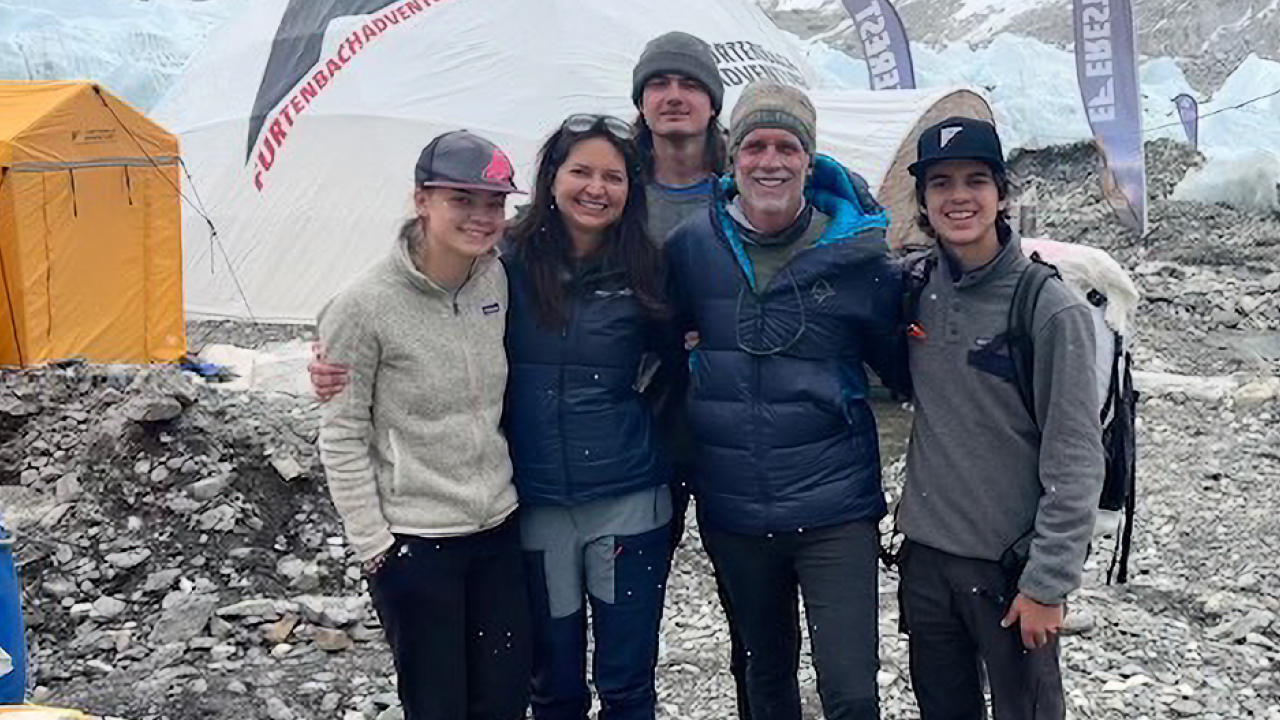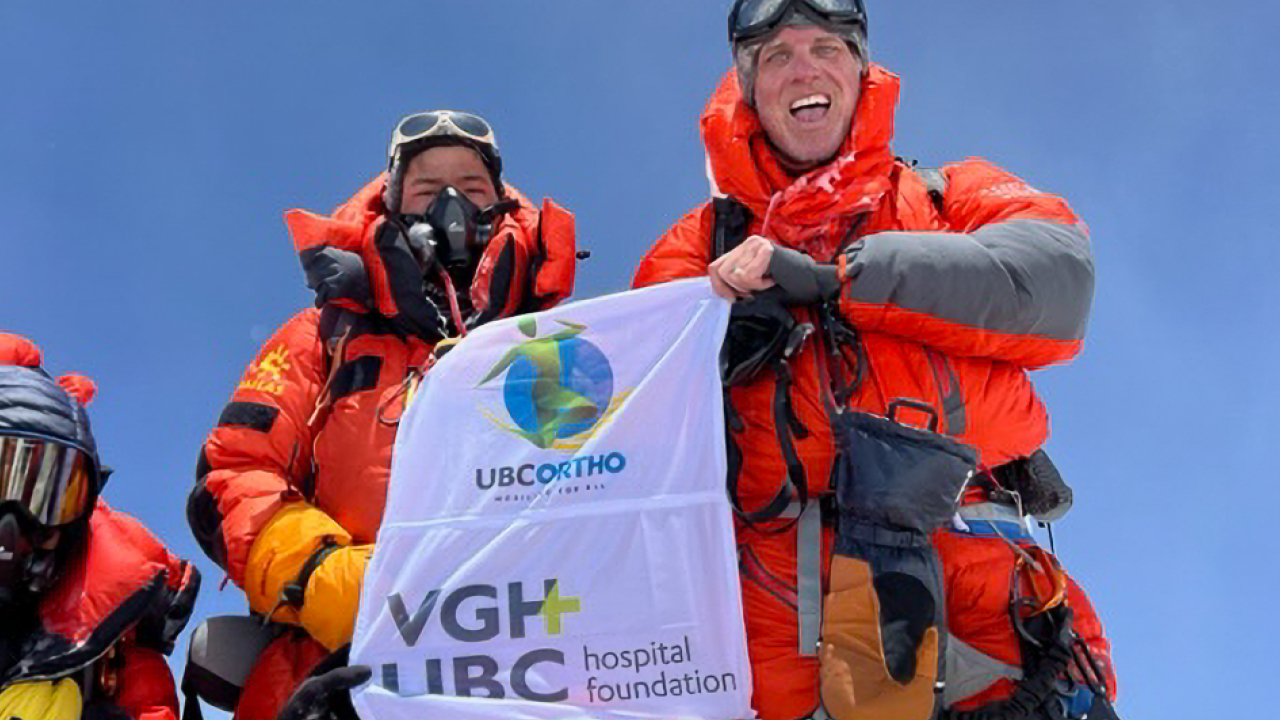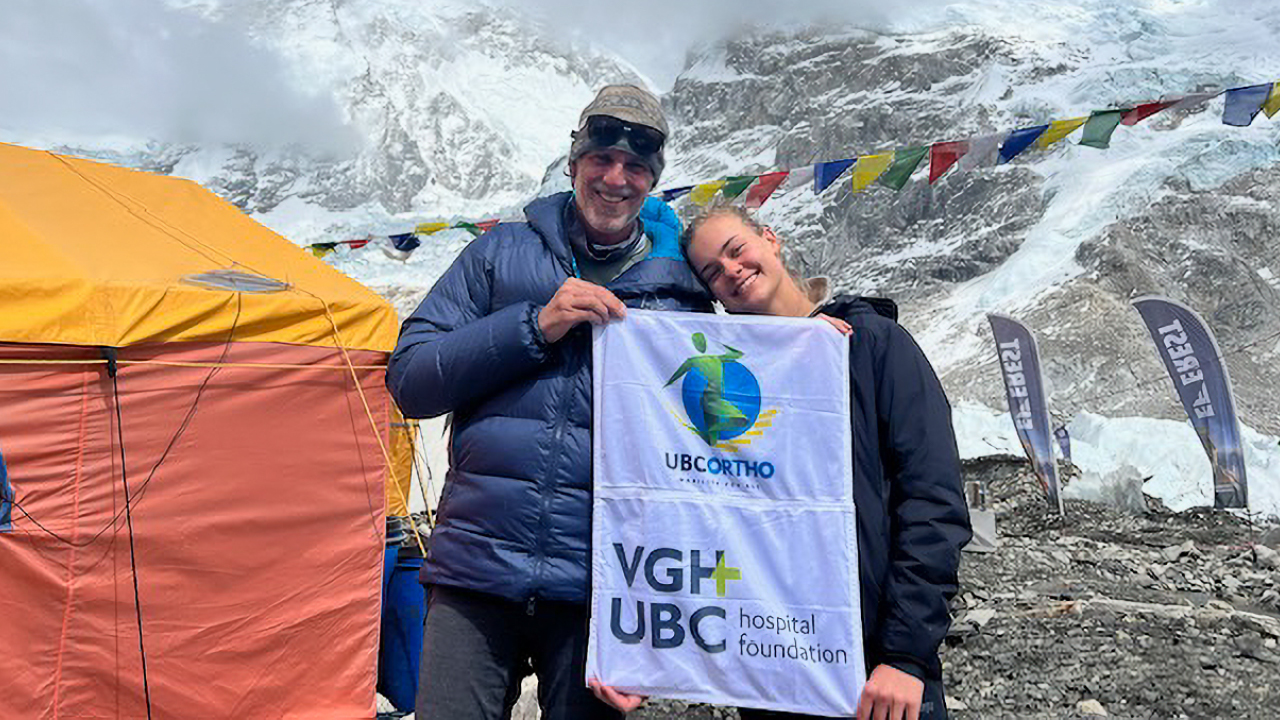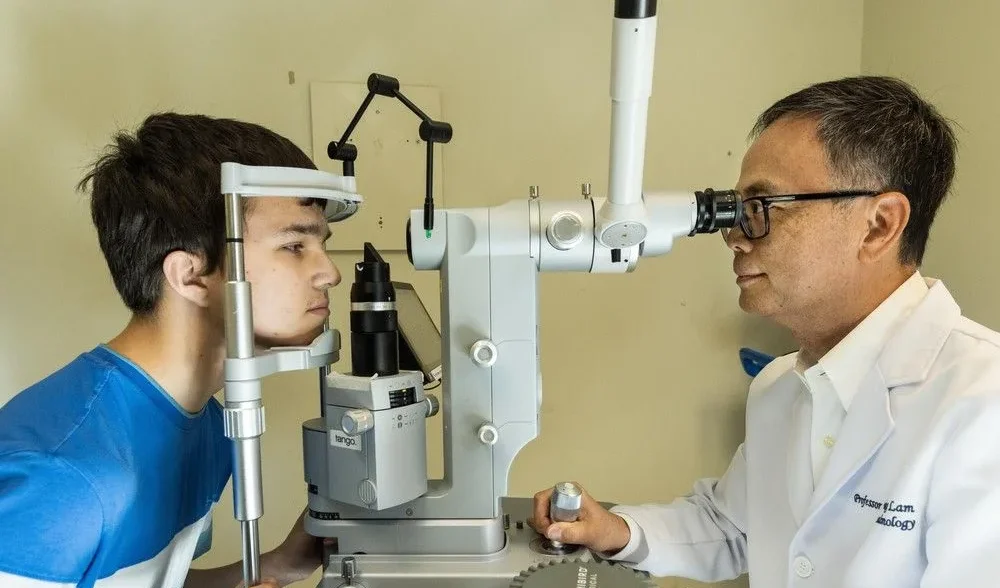Julian Bannister was having a great day. He was out skiing the mountains of Whistler, one of his favourite things to do. In fact, Julian loved the mountains, and was in training to conquer one of the world’s greatest challenges: climbing Mt. Everest.
The ski day turned disastrous for the avid mountaineer when a serious fall broke his pelvis. First taken to Whistler hospital for examination, he was soon rushed to VGH because of the nature of his injury.
“I cracked my acetabula in half,” says Julian. The acetabula are the sockets of the hipbone which the head of the femur fits into. “Within 24 hours of the accident, almost to the minute, I was in surgery.”
Julian was brought under the care of Dr. Pierre Guy, Head of the Department of Orthopaedics at VGH. Dr. Guy surgically inserted a five-inch screw to bind the bones, and gave Julian a recovery plan. He was going to have to do extensive physiotherapy to rebuild the muscle. He wasn’t allowed to walk for two months, and altogether the recovery would take at least six.
“Muscle atrophy was the biggest issue,” says Julian. “Just trying to get back to walking and balancing the muscle strength of my legs after that. I did all the recovery work and within six months, I was back.”
Almost one year later, his daughter Lexy Bannister was out in the Yukon for a skiing competition and similarly found herself in a dire situation. She took a jump and landed, hard, tumbling along the ground and cracking her pelvis in three places.
“Originally they didn’t think much was wrong with me,” says Lexy. “Some of the coaches were like, ‘Okay, take a deep breath’, and then I was like, ‘No, I can’t lie on that side.’”
“It’s awful,” says Karen Sander, Lexy’s mother. “It is the scariest, most awful thing, especially as a parent to get a phone call saying your child has been hurt.”
Lexy was first taken to a local hospital in Whitehorse where she was examined and stabilized. After three days, she was well enough to be flown to VGH. In another twist of fate, Dr. Guy was on rotation the night Lexy arrived, and ended up caring for her too.
Lexy wouldn’t need surgery, but like her dad, couldn’t stand for two months and was given a physiotherapy plan to fully recover as well.
Both father and daughter’s recovery plans went by the book. And in all that time, Julian never lost sight of his goal.
“He’s been working his way towards Everest for a decade as a mountaineer,” says Karen Sander, Julian’s partner and Lexy’s mother. Karen is also a member of the Foundation’s Patrons’ Council, an exemplary group of dedicated and passionate supporters who advise and assist in fulfilling our mandate.
“He wasn’t going to quit.”
Never quitting

In May 2023, after many long years of setbacks, trials and tribulations, Julian, Lexy, Karen, and their two sons finally flew to Nepal to support Julian’s attempt to ascend Mt. Everest. Julian and Lexy had recovered well enough after receiving care at VGH to be there—with Lexy alongside her mom and brothers hiking to base camp, and Julian to do the final climb of the world’s tallest mountain—all 8,849 meters.
“The scale of the Himalaya is something we can’t really wrap our heads around and imagine,” says Karen.
“An expedition like this takes over everything,” says Julian. “It’s such a big endeavor, financially, emotionally, time-wise, physically, all those things. It became a pilgrimage for me and after everything I had been through, I felt successes just getting on the ground into Kathmandu and then just getting up into the Himalaya and then just getting to base camp.”
Yet Julian’s focus never wavered. He had prepared for this for years. He had trained his body and his mind for the six-week journey, even running double Grouse Grinds back-to-back carrying a 30-pound bag of dog food on his back. He spent countless days in the Rockies and Coastal Mountains ice climbing, ski touring and mountaineering to prepare in every way possible.
He was ready.
“It was beyond physically taxing some of the movement days from camp to camp. Some were easier than others but there was a couple in particular that were so draining that you wonder if you can keep going. And then you rest and eat and sleep and you are like OK I can keep going and I’ve got to do it again the next day and then the next day and then the next,” says Julian.
After five of the longest days of his life, and years of preparation and training, Julian Bannister finally achieved the near-impossible.
Julian climbed to the top of Mt. Everest.

At the summit Julian tried to take it all in and really process that he had made it to the top of the world, but then it was time to repack and prepare for the descent. Before leaving, Julian was able to take a moment to radio down and speak to Lexy to let her know her dad had done it.
“And then he came down and I was like, ‘Oh my God.’ And I cried and I was like, ‘I’m so happy you’re okay. And you summited.’ There were a lot of emotions—a million things,” says Lexy.
Karen could breathe a sigh of relief.
The journey was complete, and above all, Julian was safe.
Julian believes that VGH was essential to his remarkable achievement.
“After everything we went through, having the ortho team at VGH was incredible. They set us up for success,” says Julian.
“It’s pretty remarkable what we have available to us, and the support systems that are in place,” says Karen. “It’s a great place to put your philanthropic dollars with how much of an impact it has on everybody.”
Phil and Jennie Gaglardi Surgical Centre
In 2021, 16 new state-of-the-art operating rooms were opened to the public thanks to the passionate support of thousands of donors across the province. These new spaces include cutting-edge technology to support even the most complex surgical cases in the province, reducing wait times, optimizing outcomes, and improving care.
Lottery support
Utilizing funding from the Hometown Heroes lottery this year, many surgical tools and equipment were purchased to better support patients at VGH. This includes an irrigating cautery machine, which is used for micro, macro, and endoscopic bipolar cutting and coagulation of tissue and sealing of blood vessels, new bedside physiologic monitors which provide a complete suite of patient monitoring parameters to improve outcomes, and 3D ultrasound probes to enhance capacity for management, diagnosis and treatment for all manner of cases.
Share this:



